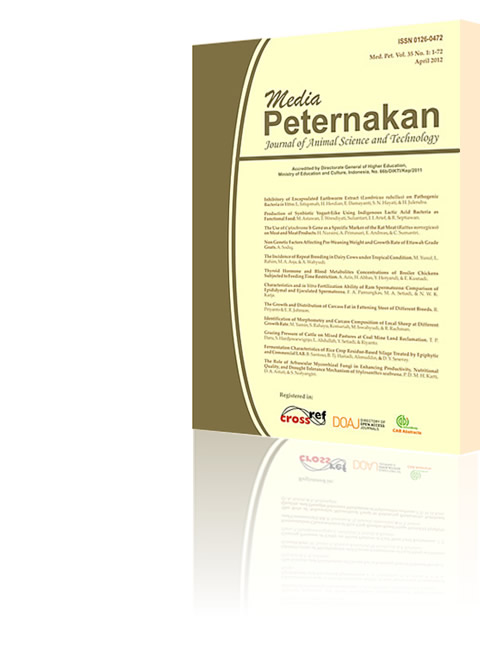-
M Yamin
-
S Rahayu
-
. Komariah
-
M Iswahyudi
-
R Rachman
Keywords:
selection, local sheep, growth, morphometry, carcass production
Abstract
Sheep fattening farms have been recently growing rapidly to produce better quality of sheep meat and fullfill consumer's demand. Sheep fattening and breeding farms should be developed proportionally to obtain sustainable sheep flock in the market. Twelve male lambs (less than one year old) were selected based on their average daily gain (ADG), consisting into two groups: 6 fast growing (FG) and 6 slow growing (SG) sheep. Some morphometric parameters in body and head parts of sheep and their carcass production and composition were measured and compared between the groups. The results show that chest circumference, body height, body length, head length and muzzle, top and bottom neck circumferences of FG sheep were significantly higher than in SG sheep (P0.05). It is concluded that selection of fast growing sheep can be recommended by using some morphometric parameters. The selection would not also negatively affect the weight and percentage of carcass composition.
Downloads
Download data is not yet available.
Author Biographies
M Yamin
Department of Animal Production and Technology
Faculty of Animal Science, Bogor Agricultural University (IPB
Jln Agatis, Kampus Darmaga, Bogor 16680, Indonesia
S Rahayu
Department of Animal Production and Technology
Faculty of Animal Science, Bogor Agricultural University (IPB
Jln Agatis, Kampus Darmaga, Bogor 16680, Indonesia
. Komariah
Department of Animal Production and Technology
Faculty of Animal Science, Bogor Agricultural University (IPB
Jln Agatis, Kampus Darmaga, Bogor 16680, Indonesia
M Iswahyudi
Department of Animal Production and Technology
Faculty of Animal Science, Bogor Agricultural University (IPB
Jln Agatis, Kampus Darmaga, Bogor 16680, Indonesia
R Rachman
Department of Animal Production and Technology
Faculty of Animal Science, Bogor Agricultural University (IPB
Jln Agatis, Kampus Darmaga, Bogor 16680, Indonesia
Authors submitting manuscripts should understand and agree that copyright of manuscripts published are held by Media Peternakan. The statement to release the copyright to Media Peternakan is stated in Form A. This work is licensed under a Creative Commons Attribution-ShareAlike 4.0 International License (CC BY-SA) where Authors and Readers can copy and redistribute the material in any medium or format, as well as remix, transform, and build upon the material for any purpose, but they must give appropriate credit (cite to the article or content), provide a link to the license, and indicate if changes were made. If you remix, transform, or build upon the material, you must distribute your contributions under the same license as the original.



